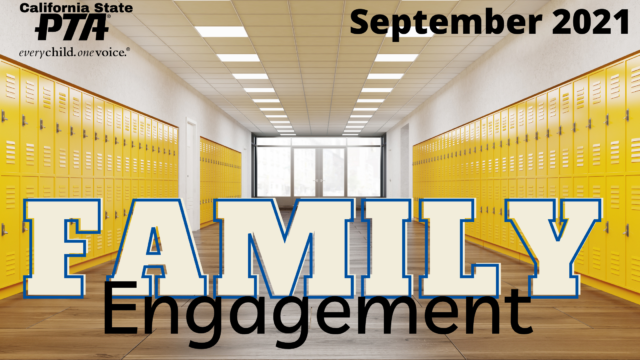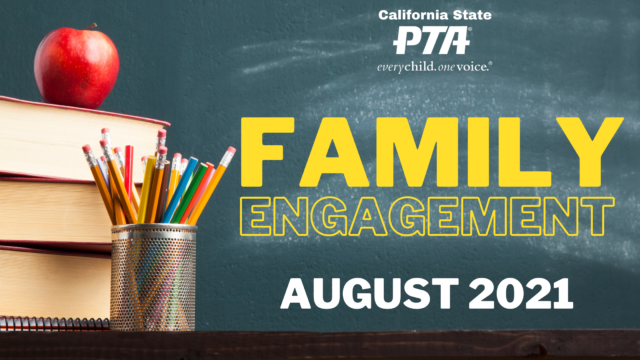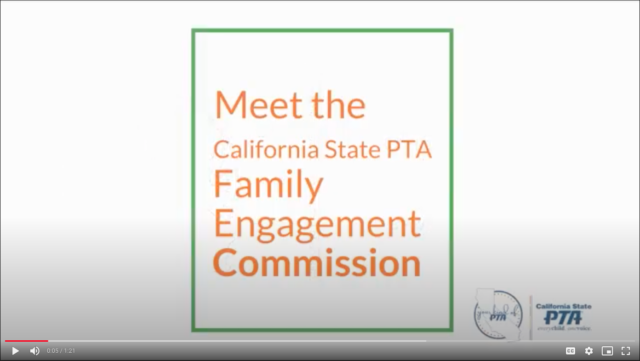by Heather Ippolito, VP Family Engagement

This coming week National PTA celebrates Back to School Week. From September 13-17 they are hosting activities and encouraging school sites across the country to hold events to welcome students and their families back to campus. Visit their website to see a wealth of resources for encouraging families to join your PTA and ideas for how to do PTA activities virtually or in a hybrid fashion. Also be sure to follow their social media channels so that you won’t miss any of the fun ideas and activities they will be sharing all week long.
The California State PTA Family Engagement Commission has some back to school ideas for you to use now as well– regardless if your community started school this week or a month (or more!) ago — these are events we know work! We’ve held them at our schools to help students and families feel connected as school resumes.
- Boo Hoo/Yahoo Breakfast for Parents- The first day of school is hard on parents, especially for our TK or Kindergarten families. They are having to leave their little one on campus for the first time and it can be a little stressful on both parent and child. While the teachers are taking care of the kids in the classroom, our PTA hosts a coffee and continental breakfast for parents. Our principal comes and introduces themself, families have an opportunity to meet other parents, and our PTA shares a little bit about our programming and the benefits of becoming a PTA member. The event doesn’t last more than an hour on the first morning of school, but it was always a family favorite event. School already started? There is no reason not to hold this to celebrate the first week, month or quarter!
- Ice Cream Social- Prior to the start of the school year, we invited families to campus for an ice cream social. We bought giant bags of popsicles and ice cream from either the cafeteria or a warehouse store, set up a table on the school playground, and allowed families, students and our PTA to mingle. The kids loved the opportunity to see their friends and play, while the parents greatly appreciated the sense of community they began to form with other families at school. School already started? Everyone in your community will love ice cream on the second week, or the eighth just as much as the first day.
- Family Picnic- Our school held a family picnic on the Friday after the first week of school. We encouraged families to bring blankets, chairs and their dinner to the school playground. PTA had music playing, we invited an ice cream truck or a mobile shaved ice company to park near the school, and we sometimes put out games like the parachute or giant connect four for kids and families to play. It was a wonderfully low-key way to chat with other families, for kids to show their parents the cool playground that they had been exploring all week long, and oftentimes our administration or some teachers dropped by. School already started? Picnics can happen anytime!
- Have your Mascot welcome the kids to school on day 1- Most schools have some sort of costume that goes along with the school’s mascot. Ask for a parent volunteer to wear it on the first day of school as the children arrive. This is a great photo opportunity, it helps ease the anxiety of some children to be welcomed by a friendly face, and you can promote your PTA by asking them (or their assistant) to hold a “Join PTA” sign with a QR code that links them to your membership site. School already started? Your Mascot can bring the party any day of the fall semester!
Note: Try to have your back-to-school events be no-cost or low-cost. You don’t want price to be a barrier to attendance at welcome back events– this is a chance for all families to feel welcome on your campus. These give-back events are for relationship building and to help our children and families feel comfortable at school. They shouldn’t be for fundraising.
If your school isn’t allowing on-campus events this fall many of these things can be held in a local park, community center, library, or other non-campus location. Or modify your event to make it virtual: Coffee with the Principal (on Google Meet) or a drive through ice cream social with student made signs on the vehicles, or even a socially distant ice cream social!. This may mean a little extra planning on your part, but the returns in helping families and students feeling connected to one another and to your school will be worth the investment of your time.




